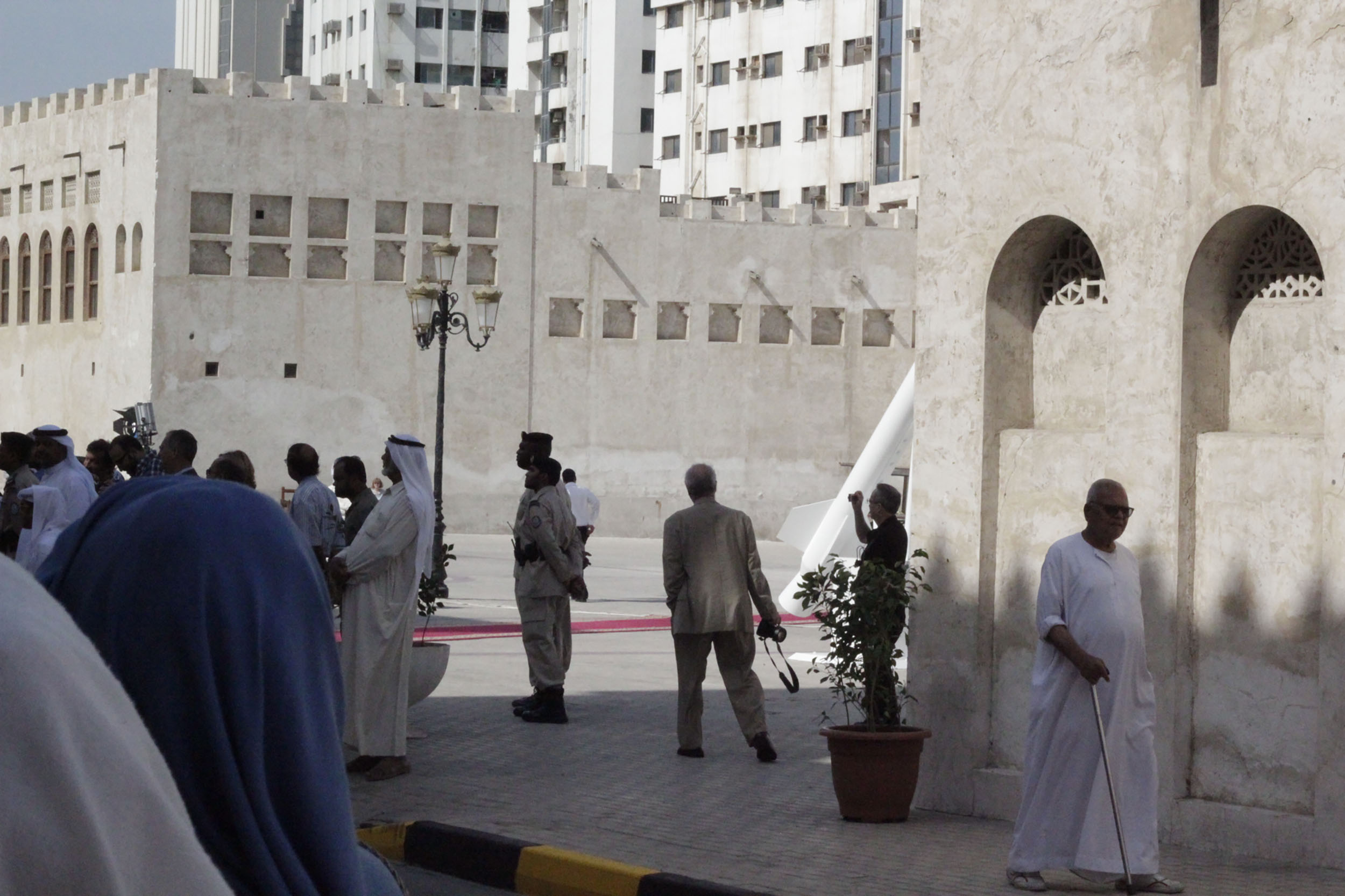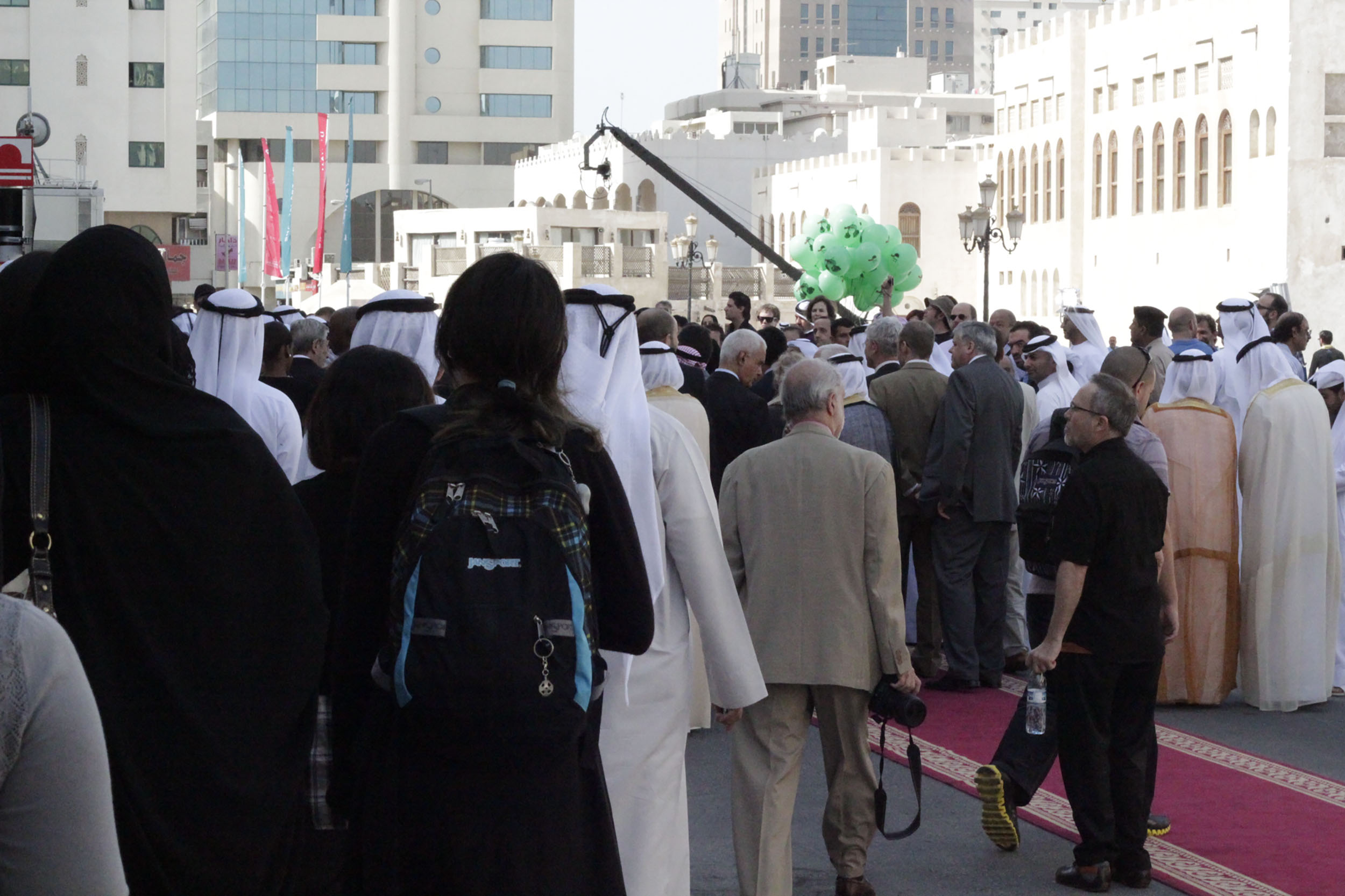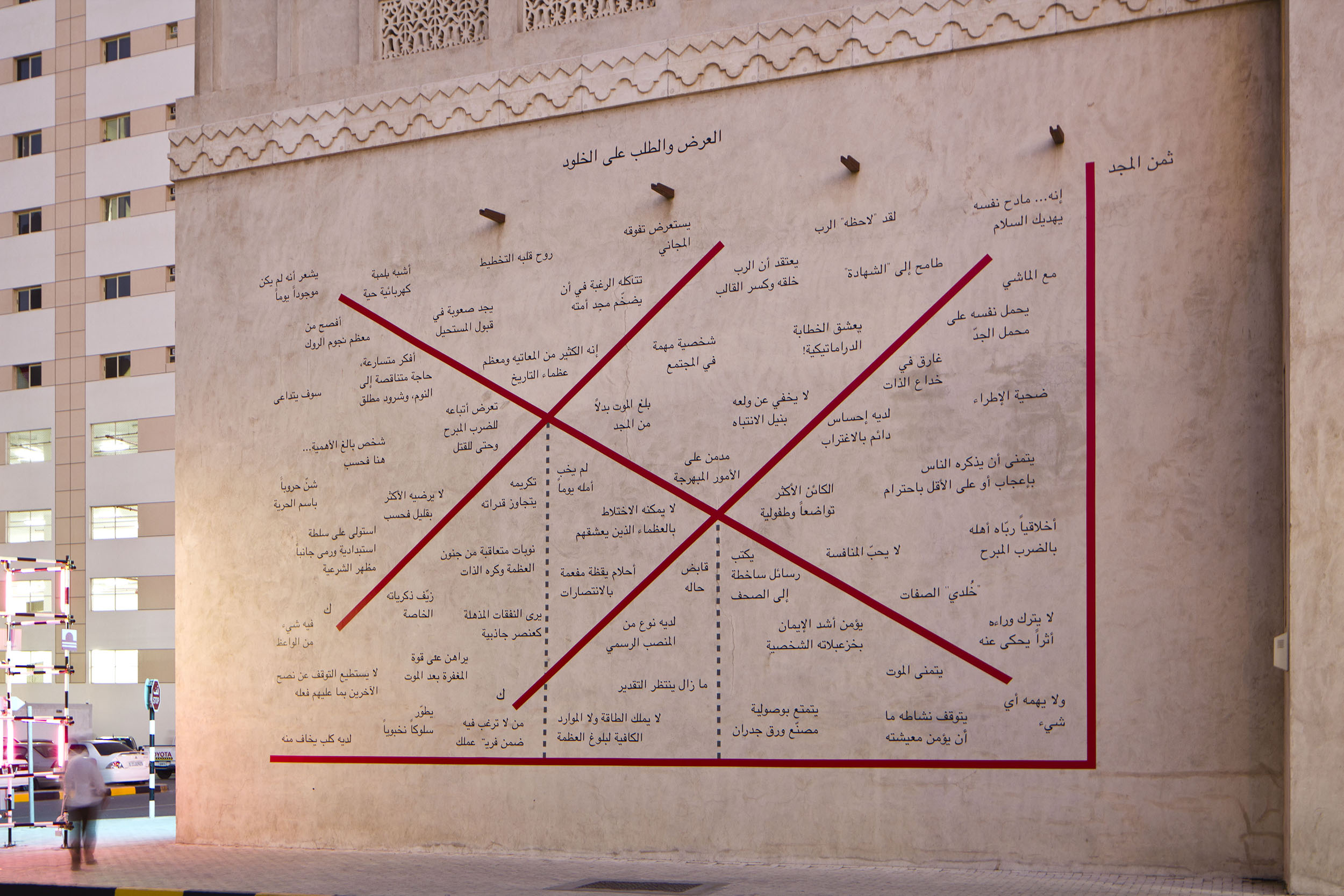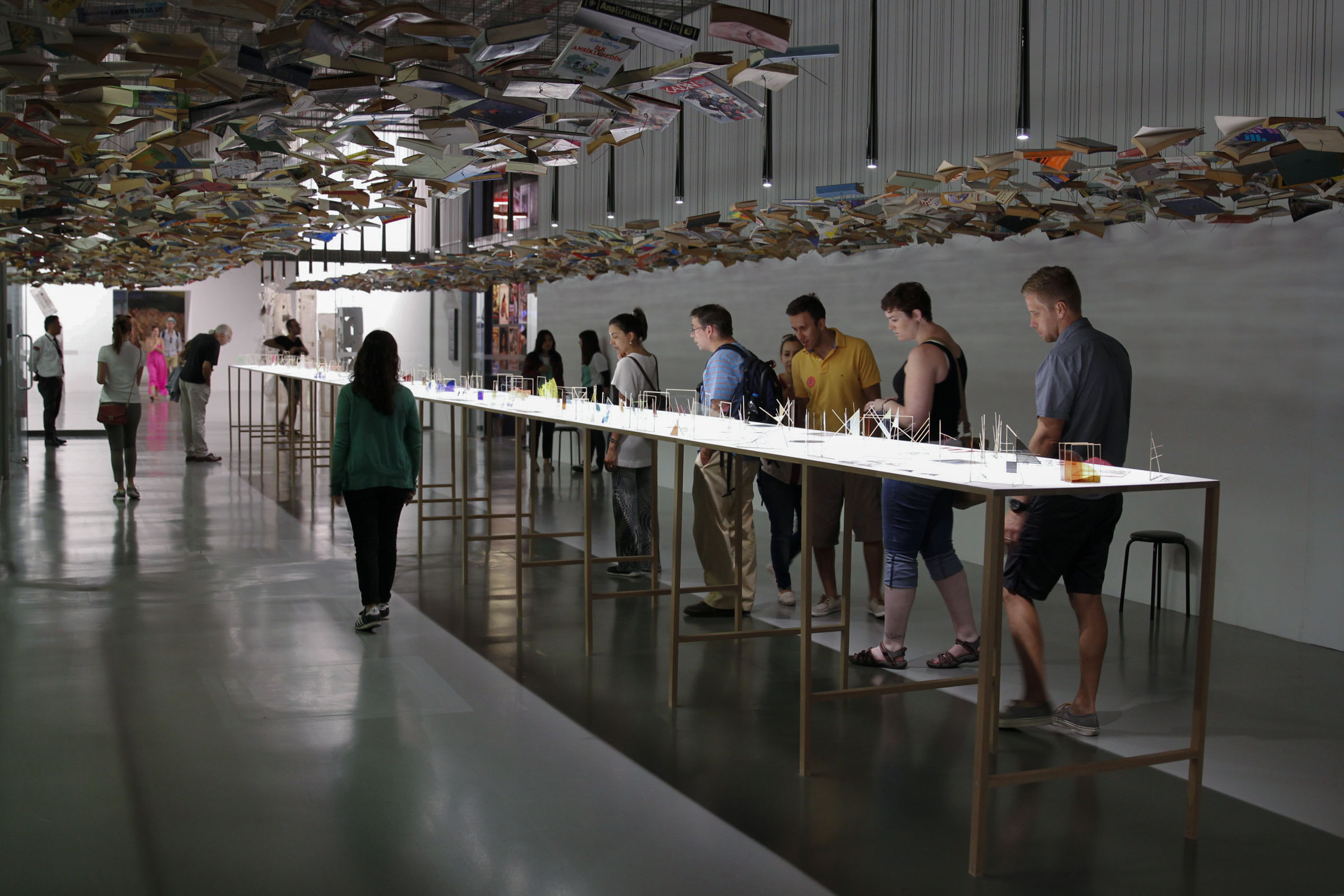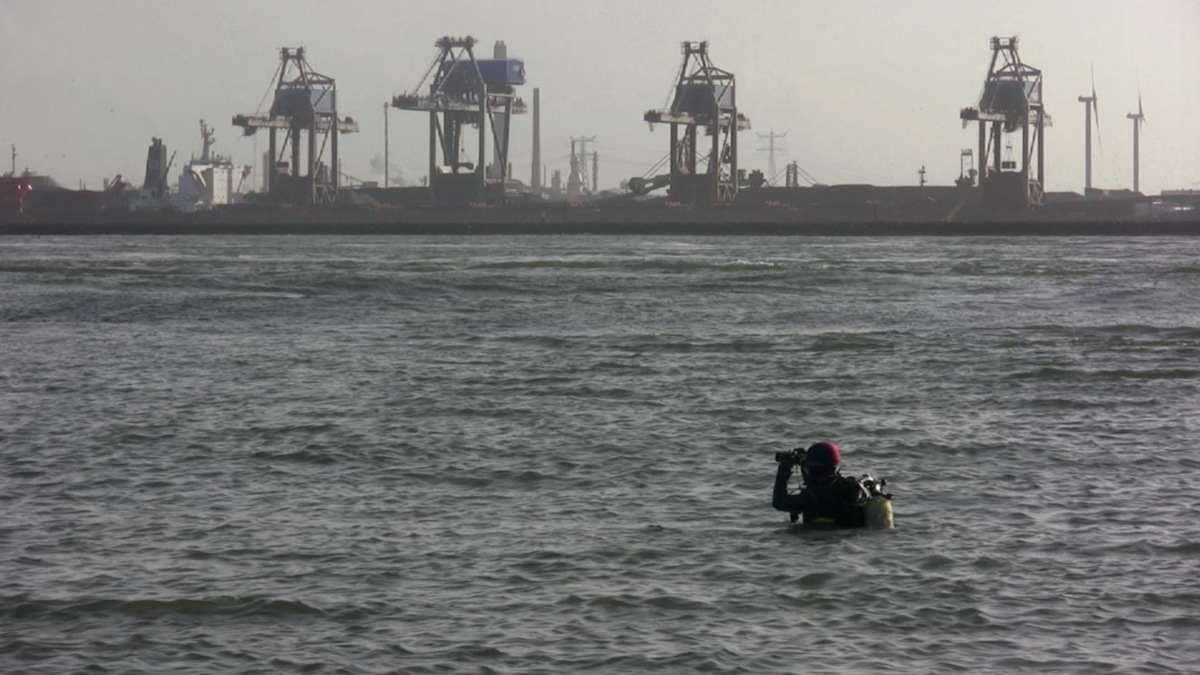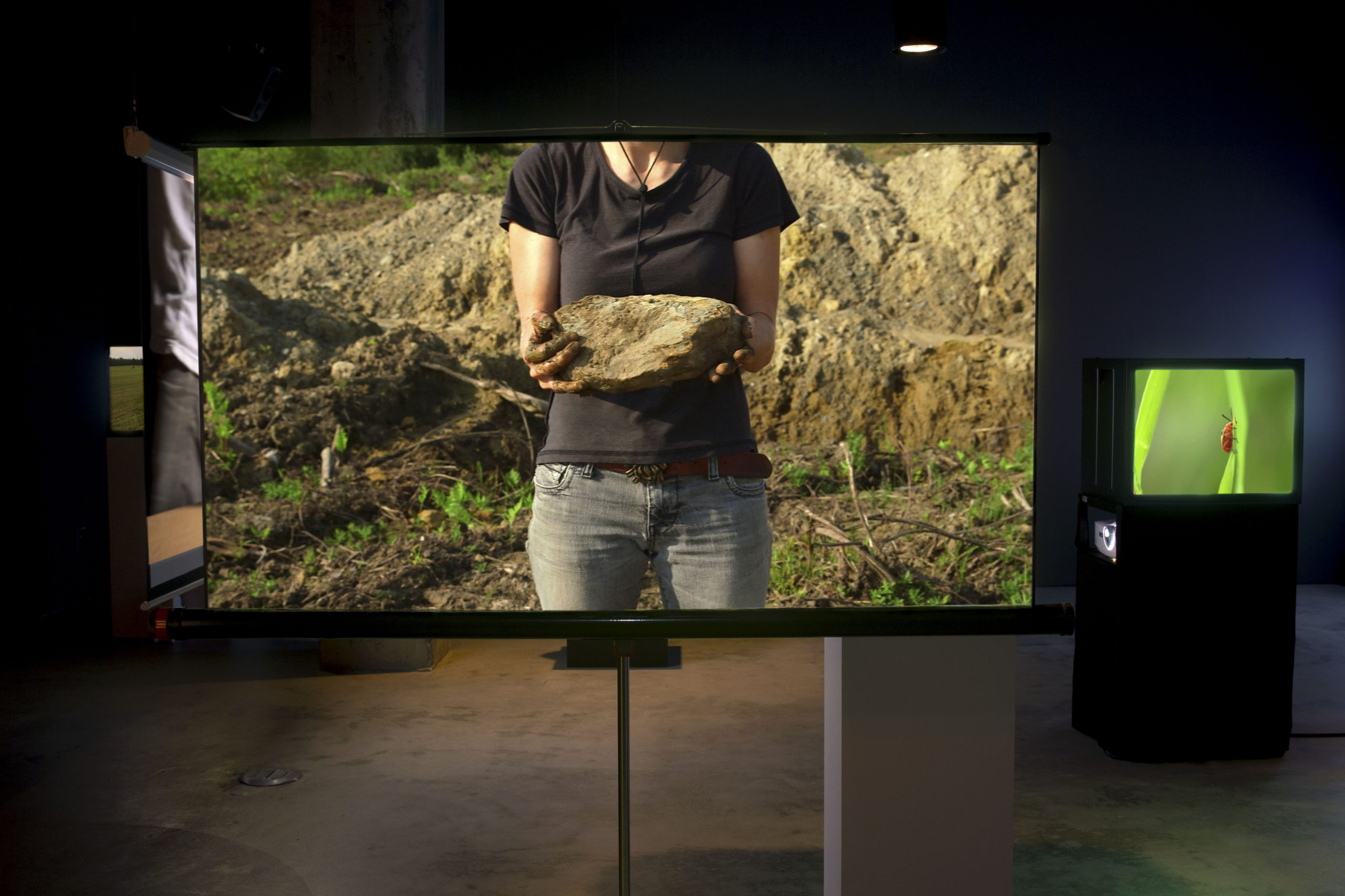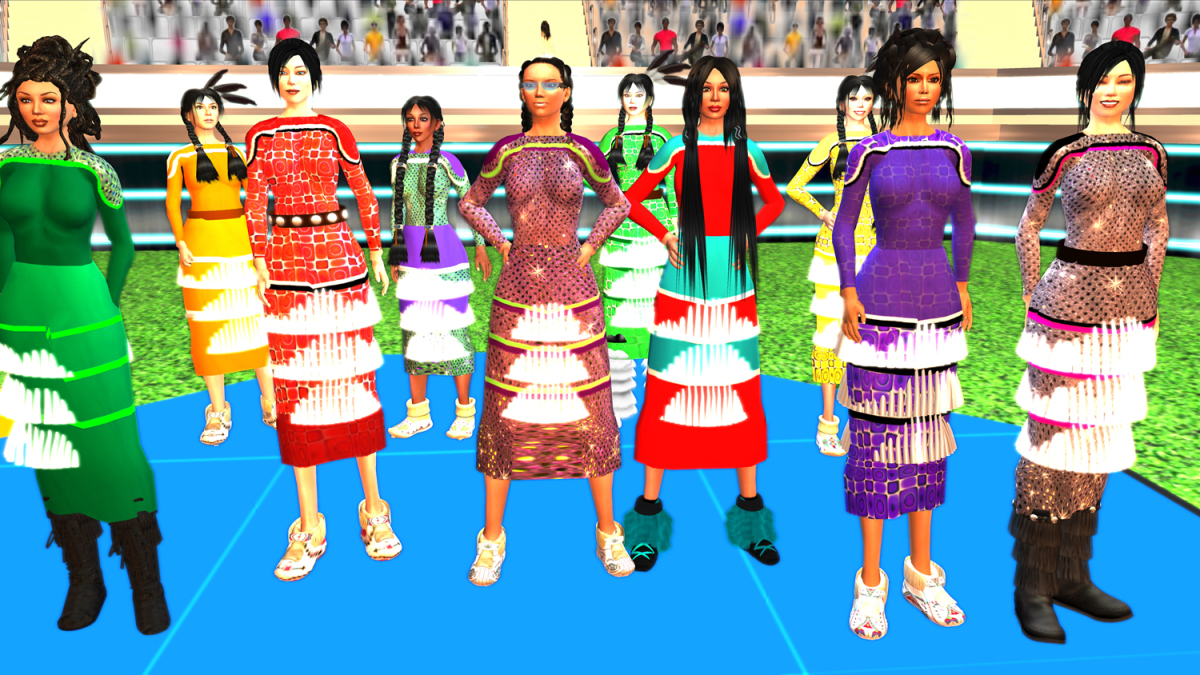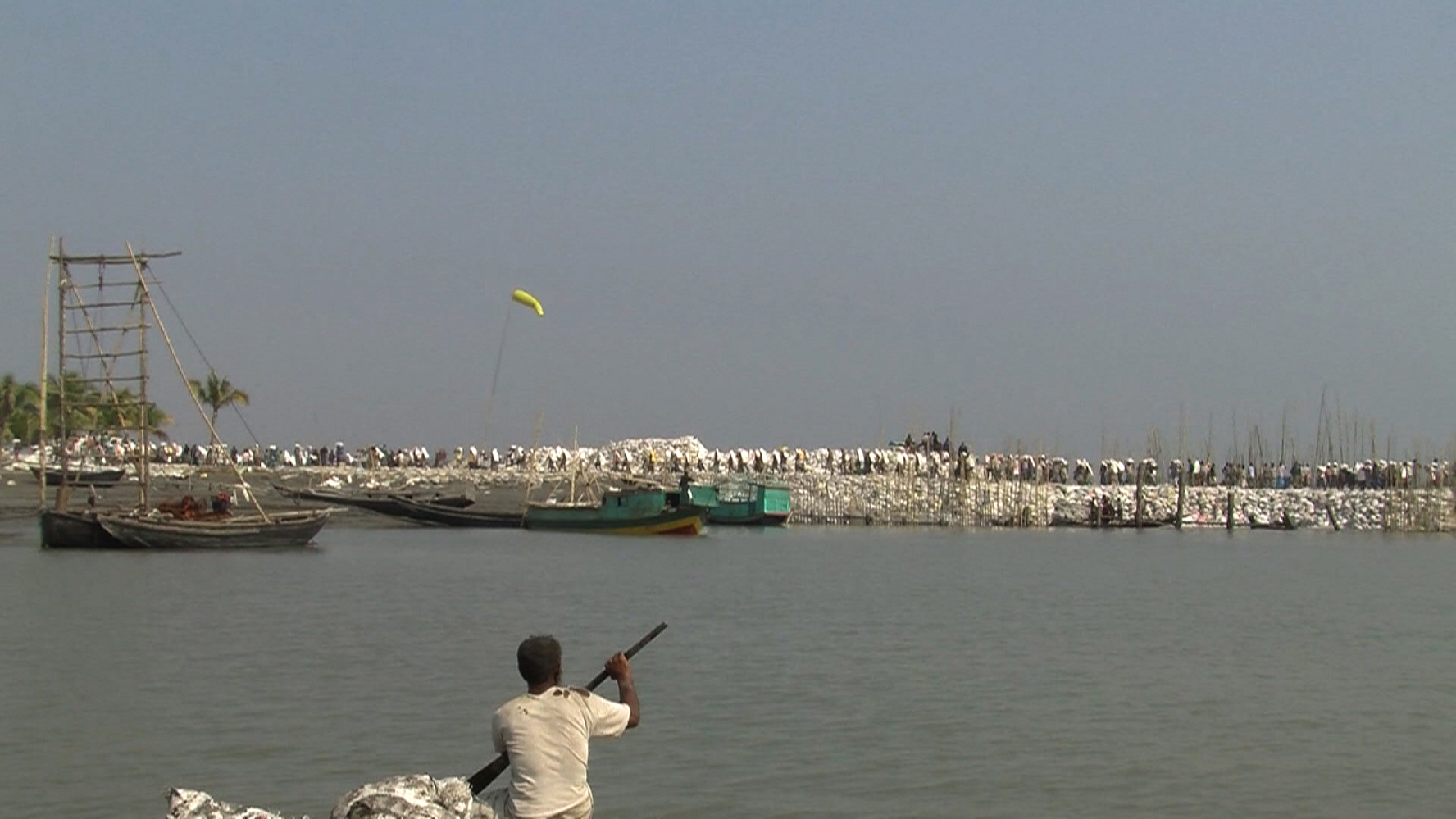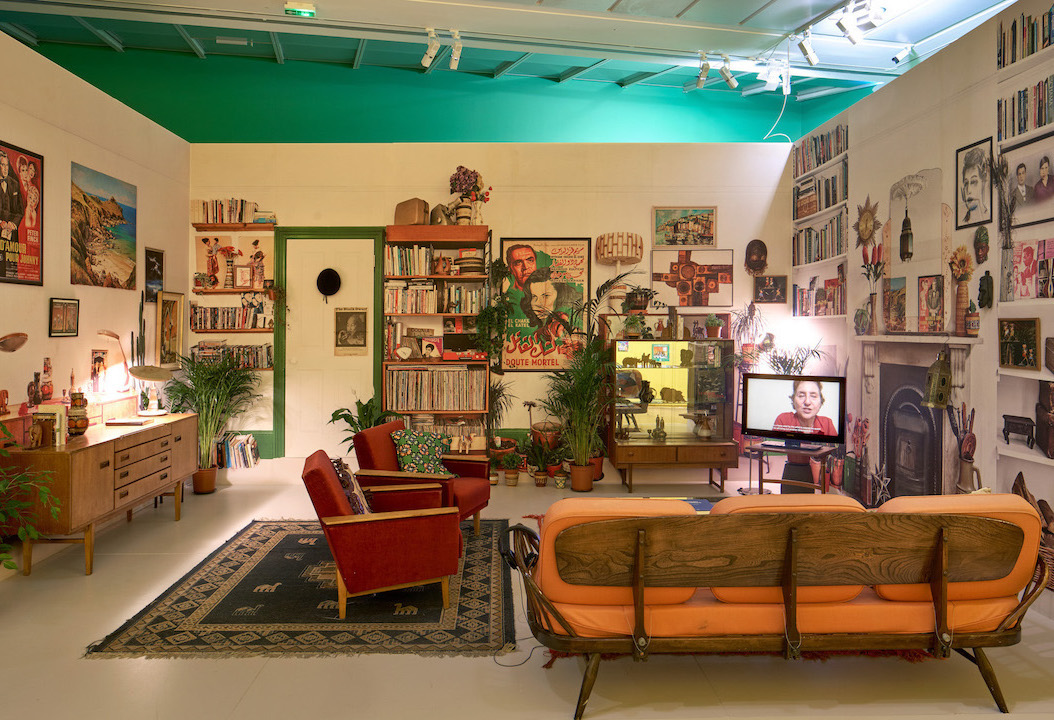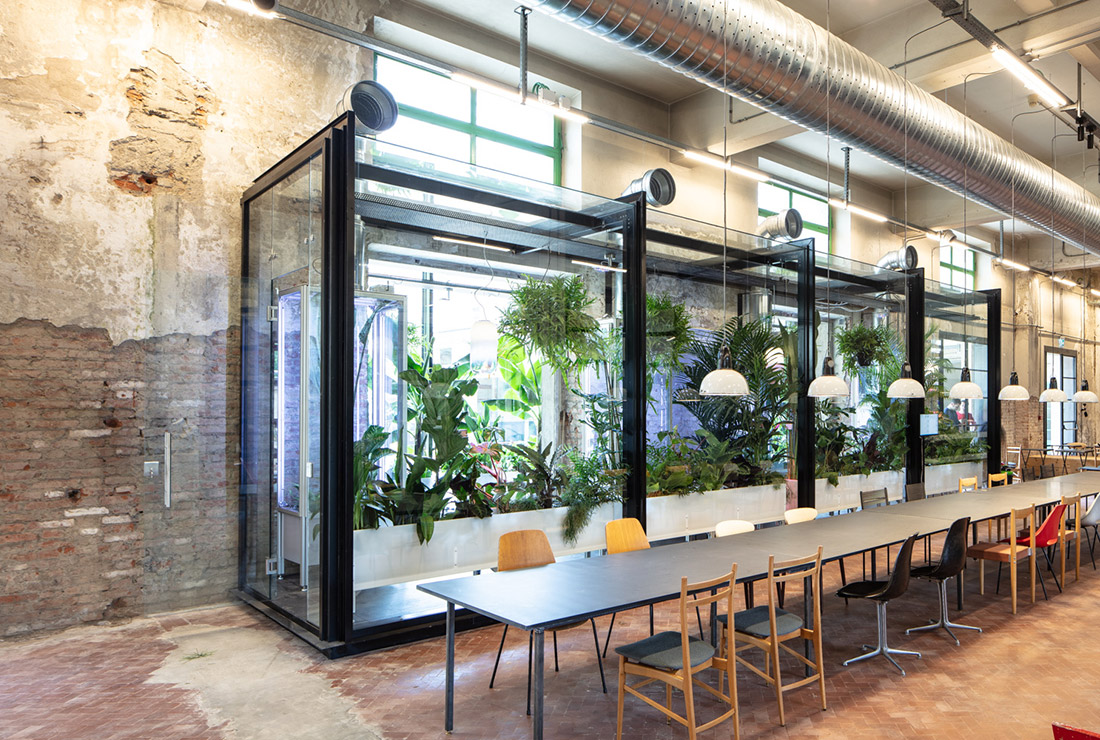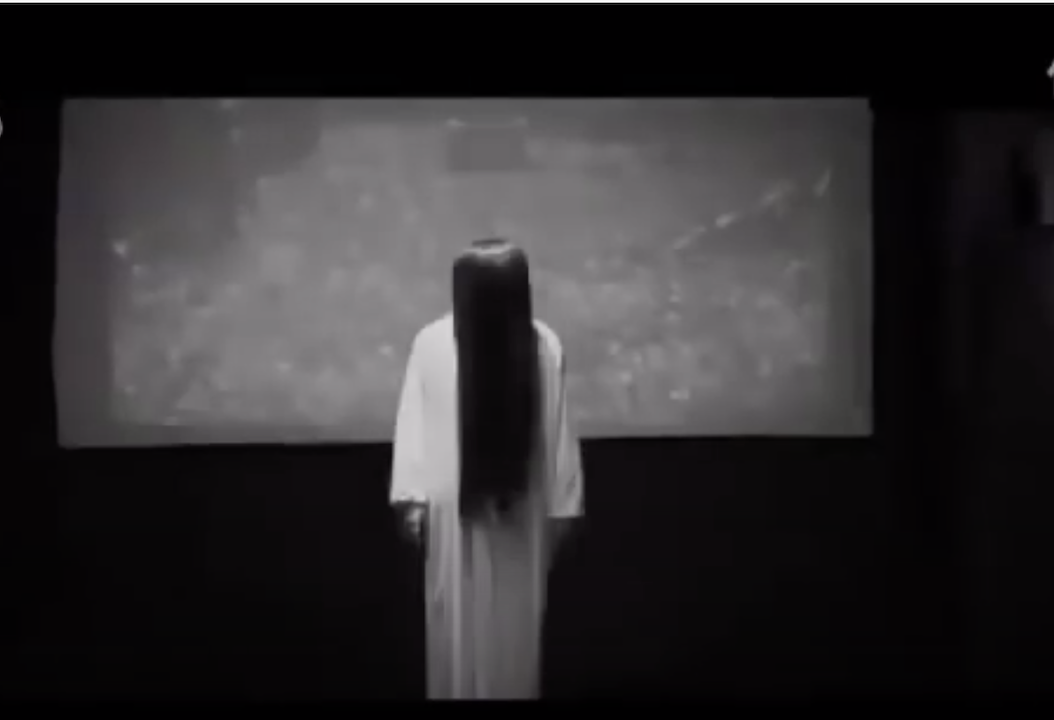RICHARD IBGHY & MARILOU LEMMENS
Plots from (Three) Biennials
- 17.12.2018
Richard Ibghy & Marilou Lemmens, Supply and Demand for Immortality, 2011
Two murals. 9.5 m x 15 m each. Installation view at the Sharjah Art Museum. 10th Sharjah Art Biennial, Sharjah, UAE, 2011. Commissioned by the Sharjah Art Foundation. Photo: Richard Ibghy & Marilou Lemmens
In 2011, we were invited to participate in the 10th Sharjah Biennial, in the United Arab Emirates. The timing of the biennial coincided with the democratic uprisings – known collectively as the Arab Spring – in the Middle East and North Africa. In Tunisia, decades of autocratic rule and economic hardship erupted into mass demonstrations in late 2010 when Mohamed Bouazizi set fire to himself after a police officer stopped him from selling fruits and vegetables. These demonstrations led to the overthrow of President Zine El-Abidine Ben Ali. Soon, the regimes in Algeria, Jordan and Oman had announced reforms or even changes of government. In Cairo, the demonstrations in Tahrir Square made people feel that a complete regime change might happen in Egypt, and President Hosni Mubarak was soon overthrown.
Among the artists at the UAE biennial from neighbouring countries, there was a sense of hope and optimism that real political transformation in the region was on its way. The unthinkable was now a possibility. During the opening, as Sharjah’s Sheikh Sultan bin Muhammad Al Qasimi was on his inaugural tour of the biennial, a group of artists from around the world stood outside the Sharjah Art Museum, handing out papers bearing the names of Bahraini citizens tortured and killed in the uprisings in their home country. The next morning, an impending boycott of the biennial signed by 130 artists, curators and writers was announced, unless the Guggenheim Foundation ensured that the workers it employed to build the Guggenheim museum in Abu Dhabi were given fair conditions.
Richard Ibghy & Marilou Lemmens, Supply and Demand for Immortality, 2011
Two murals. 9.5 m x 15 m each. Installation view at the Sharjah Art Museum. 10th Sharjah Art Biennial, Sharjah, UAE, 2011. Commissioned by the Sharjah Art Foundation. Photo: Richard Ibghy & Marilou Lemmens
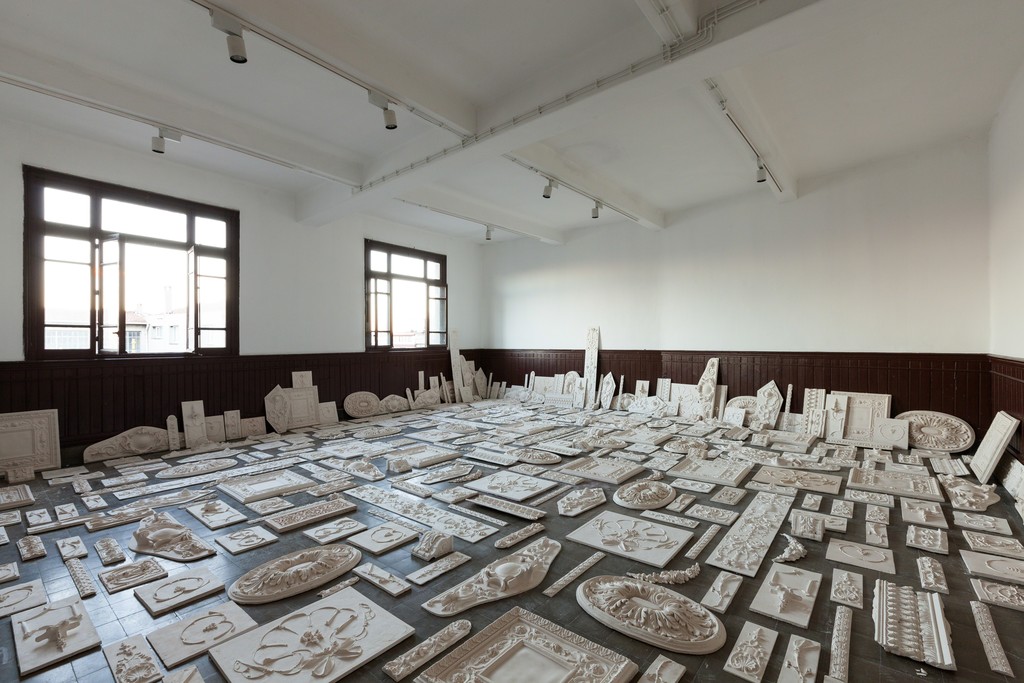
Michael Rakowitz, The Flesh Is Yours, The Bones Are Ours, 2015. Plaster moulds, casts, dog skeletons from Sivriada, bones of livestock from dispossessed Armenian farms in Anatolia, fragments of lost Louis Sullivan buildings in Chicago, rubbings, photos and letters. Dimensions variable. Installation view at Galata Greek Primary School. 14th Istanbul Biennial, SALTWATER: A Theory of Thought Forms.
The biennial itself, entitled Plot for a Biennial, was a multifaceted event involving the presentation of visual art, a film and video programme, concerts, publications and public talks. Artworks were situated across Sharjah in venues including art spaces, landmark architectural sites and traditional houses. With its thematic of the ‘plot,’ the biennial engaged with narratives of treason, trade and translation – concepts that resonated with the history, culture and economy of the region. While the activist coalition of the opening days called upon the responsibility of artists with a view to action, the artworks offered other levels of engagement and reflection. Through historical and archival research, representations and re-enactments, speculative gestures and fabulations, they illuminated the present.
A few years later, in 2015, we were invited to participate in the Istanbul Biennial. That summer, President Recep Tayyip Erdoğan’s party, the Justice and Development Party (AKP), had lost its parliamentary majority in the elections. To secure a more decisive victory, he had called a fall election while his government inflamed nationalist sentiments, ended the peace process with the Kurdistan Workers’ Party (PKK) and waged an offensive in the east of the country against Kurdish populations, effectively reigniting a 30-year-old conflict.
A group of artists intent on using the visibility of the biennial to bring attention to the recent political targeting of Turkey’s Kurdish minority, and to show support for peaceful coexistence, sent a letter to biennial participants proposing that all presentations of the works be momentarily suspended during the opening.1 This initiative sought to impart a sense of urgency to a biennial programme that mostly avoided engaging with Turkey’s current political context. Instead, the works of several artists turned to earlier moments in the history of the region and in particular to the Armenian genocide, which is still not recognised by the Turkish state.
Entitled SALTWATER: A Theory of Thought Forms, the biennial presented a broad intellectual inquiry into the development of visual forms of thought across the arts and sciences over the last century as well as incursions into the cultural and physical dimensions of the geographical context.
Through these two examples, our point is to call attention to one of the things we believe biennials do best: they serve as platforms for artistic practices and discursive forms to reflect on the biennial’s relationships to the sociopolitical context in which they are embedded. This self-reflexive model enables regional, social, political and economic issues to be presented in a meaningful way to a global audience. When biennials adopt such an approach, they become critical sites of experimentation that reflect contemporary art’s development and opportunities for grappling with complex issues, including their own set of social, economic and political pressures.
These two biennials demonstrated that they could generate new identities, reach into their respective repressed and marginalised histories and delve into social and political realities that are often ignored by the dominant media. They showed that they could not only ferment countermovements leading to concrete actions, but also instigate and nurture the proliferation of alternative discourses and fictions. This proliferation is essential to resisting the mobilisation of self, which Miwon Kwon aptly described as the reduction of identities and place-identities to discursive fictions in her essay “One Place after Another: Notes on Site Specificity.”2
Michael Rakowitz, The Flesh Is Yours, The Bones Are Ours, 2015. Plaster moulds, casts, dog skeletons from Sivriada, bones of livestock from dispossessed Armenian farms in Anatolia, fragments of lost Louis Sullivan buildings in Chicago, rubbings, photos and letters. Dimensions variable. Installation view at Galata Greek Primary School. 14th Istanbul Biennial, SALTWATER: A Theory of Thought Forms.
If biennials can serve as platforms to promulgate historically and geographically situated issues to an international audience, the inverse is also the case: they can also serve as platforms for international issues to gain local and national currency. In this respect, the 2014 edition of the Biennale de Montréal is a good case in point. Although the city of Montreal had held a biannual exhibition from 1998 to 2011, the 2014 edition was reorganised into a profoundly new entity. Unlike its previous iterations, the biennial was positioned to take its place in the global biennial network, one that could cohabitate with other international biennials in terms of the calibre of the artists invited and the attention to the presentation of the works.
The result was an ambitious, high-quality event in which artists from Quebec and across Canada were presented alongside their peers from all over the globe. In reaction to its previous life, the ‘new’ biennial was everything but focused on the city or regional concerns. Entitled L’avenir (looking forward), it tackled global issues: climate deregulation and its interconnectedness with resource extraction, finance and economics, the neoliberal extension of private property, immigration and the sovereignty and future of aboriginal peoples. Rather than foreground its site, the biennial presented something different and crucial about today’s world: that some issues can be best understood when considering their interconnected and global scale, and that acknowledging the digital flows and rippling impacts of our contemporary culture is key.
It is the fundamentally malleable nature of biennials that makes them potent sites of experimentation, testing and inquiry. Through these mutations, they can both question and reinvent themselves. This does not mean that biennials must deliver novelty from edition to edition, but that they can, and often do, engage in substantial ideological and aesthetic repositioning.
Over the past 20 years, problems associated with the proliferation of biennials and other large-scale recurring exhibitions have been discussed widely. They have been criticised for the way they bring together (and often hide) issues of power and privilege, art and market, and for their embrace of spectacle and their misuse of site-specificity. Ignoring the complex issues that make them and other large-scale exhibitions problematic is never an option, but neither should these be the only issues that are addressed. Biennials can present some of the most affirming and thought-provoking artworks of our time. For us, they have been much more than that. Each one has been an occasion to think with others about the issues that preoccupy us most. These are moments where the forces that shape the present, in a particular place or over continents, can be assessed, felt, discussed, interrogated, reimagined and shared.
NOTES
2 Miwon Kwon, “One Place after Another: Notes on Site Specificity,” October 80 (Spring 1997), pp. 85-110, http://www.usfcam.usf.edu/CAM/ exhibitions/2008_8_Torolab/Readings/One_ Place_After_AnoterMKwon.pdf.
ABOUT THE AUTHOR
Based in Durham-Sud, Canada, Richard Ibghy & Marilou Lemmens have developed a collaborative practice that spans multiple media, including video, performance and installation. Their work explores the material, affective and sensory dimensions of experience that cannot be fully translated into signs or systems.
Author’s name, “Title,” in PASS: Journal of the International Biennial Association (Month Year), URL.

